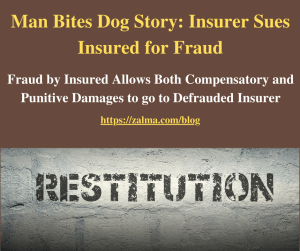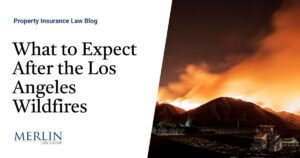Man Bites Dog Story: Insurer Sues Insured for Fraud

A
lexander Dallal and Claire Dallal (“the Dallals”) appealed following an adverse jury verdict. The jury awarded Plaintiff-Appellee Lincoln Benefit Life Company (“Lincoln”) $619,290.49 in compensatory damages and $300,000 in punitive damages. In Lincoln Benefit Life Company v. Alexander Dallal, an individual; Claire Dallal, an individual, No. 21-55152, United States Court of Appeals, Ninth Circuit (March 1, 2022).
LACK OF EXPERT REPORT DEFEATS TESTIMONY
The Dallals’ claimed their expert was improperly not allowed to testify. However, the expert witness disclosure as to Dr. Chow was untimely and was never accompanied with a report satisfying the requirements of Federal Rule of Civil Procedure 26(a)(2)(B). Accordingly, exclusion was well within the district court’s discretion.
STATUTE OF LIMITATIONS STARTS RUNNING ON DISCOVERY
The parties agree that the three-year statute of limitations found in California Code of Civil Procedure § 338(d) applies to Lincoln’s claims. This statute incorporates the “discovery rule” to “fraud actions by statute,” Cansino v. Bank of Am., 169 Cal.Rptr.3d 619, 628 (Cal.Ct.App. 2014), providing that any “cause of action . . . is not deemed to have accrued until the discovery, by the aggrieved party, of the facts constituting the fraud or mistake,” California Civil Code § 338(d).
The discovery rule is an “important exception to the general rule of accrual . . . [and] postpones accrual of a cause of action until the plaintiff discovers, or has reason to discover, the cause of action.” Fox v. Ethicon Endo-Surgery, Inc., 110 P.3d 914, 920 (Cal. 2005). Under the discovery rule, the statute of limitations does not begin to run when the last element occurs, but instead at the time the plaintiff “at least suspects that someone has done something wrong to him.” Norgart v. Upjohn Co., 981 P.2d 79, 88 (Cal. 1999) (alterations and citation omitted).
Lincoln sued December 16, 2016. This means that under the three-year statute of limitations established by California Code of Civil Procedure section 338(d), it could only recover for fraudulent claims accruing on or after December 16, 2013, unless the discovery rule applies. December 16, 2013 is the controlling date for any statute of limitations defense raised in this case and the Dallals offer no persuasive argument to the contrary.
The Dallals attempt to contort this standard into one obligating an insurer to presume it is being defrauded by its insureds and investigate claims even in the absence of any evidence of wrongdoing. This is simply not what the discovery rule requires.
SUBSTANTIAL EVIDENCE
Substantial evidence is evidence adequate to support the jury’s conclusion, even if it is also possible to draw a contrary conclusion. The Ninth Circuit did not weigh the evidence, instead, simply ask whether the plaintiff has presented sufficient evidence to support the jury’s conclusion.
The Ninth Circuit concluded that the jury’s conclusion as to the discovery rule was supported by substantial evidence. Specifically, at trial the jury was presented with overwhelming evidence that from 2004 to 2016 the Dallals systematically forged hundreds of records indicating Mr. Dallal was severely physically and cognitively incapacitated in order to wrongfully obtain insurance benefits. And during this period Lincoln did not simply take the Dallals at their word but instead conducted multiple independent nursing assessments during which Mr. Dallal feigned incapacity.
THE RIGHT TO PUNITIVE DAMAGES
The Ninth Circuit must review de novo whether a punitive damages award is excessive. The Dallals challenge the punitive damages award under both California law and the United States Constitution. California law authorizes an award of punitive damages when a plaintiff establishes by clear and convincing evidence the defendant engaged in oppression, fraud, or malice. California law prohibits punitive damage awards that are excessive as a matter of law or raise a presumption of passion or prejudice.
This state-law excessiveness analysis considers a variety of factors including the reprehensibility of the defendants’ conduct, the relation between the compensatory damages awarded and the harm suffered, and the award’s relation to the wealth of the particular defendant. California generally finds punitive damage awards exceeding 10 percent of the defendant’s net worth excessive.
The framework under which California reviews punitive damage awards remains constrained by the Constitution. State Farm Mut. Auto. Ins. Co. v. Campbell, 538 U.S. 408, 416 (2003). Generally, a punitive damage award is unconstitutional when it is “grossly excessive or arbitrary,” which requires a consideration of three factors:
the degree of reprehensibility of the defendant’s misconduct;
the disparity between the actual or potential harm suffered by the plaintiff and the punitive damages award; and
the difference between the punitive damages awarded by the jury and the civil penalties authorized or imposed in comparable cases.
In this case, a punitive damages analysis under either California law or the Constitution compels the same conclusion-the jury’s punitive damages award should remain undisturbed.
CONTRACT OF INSURANCE VOID
Over the course of nearly a decade, the Dallals systematically defrauded Lincoln out of hundreds of thousands of dollars in insurance benefits by forging documents and having Mr. Dallal feign physical and cognitive incapacity. The jury’s punitive damages award was half of the compensatory award and a fraction of the Dallals’ $4,000,000 stipulated net worth. Insurance fraud is serious misconduct, which could be met with both civil and criminal penalties under California law. Ultimately, after considering the requisite factors, the Ninth Circuit found no basis for disturbing the jury’s punitive damages award under either California law or the Constitution.
For equitable relief to issue, the benefiting party must have no adequate remedy at law and must suffer irreparable injury without it. Voiding contracts on the basis of fraud has long been considered a proper exercise of equitable power.
The district court concluded that the Dallals’ fraud had irreparably damaged Lincoln’s ability to trust them, and that continuance of the policy would require the expenditure of a disproportionate amount of resources, justifies the use of equitable powers in this case.
Because the parties agree Lincoln has no mechanism to cancel the Policy absent equity, it lacks an adequate remedy at law. Even if the policy separately insured both Mr. Dallal and Mrs. Dallal does not prevent a total cancellation of the policy because the evidence established they were both active participants in the fraudulent scheme.
California does not allow an insurer to sue its insured for breach of the covenant of good faith and fair dealing even when as abusive as in this case. However, as this case proves, an insurer may successfully sue an insured for fraud and may obtain both compensatory and punitive damages from its insured. Since the Dallals had a net worth of more than $4 million a $300,000 punitive damage award was minor and more than fair. Lincoln should be commended and emulated by any insurer who has evidence that an insured has defrauded it. Perhaps Travelers who was proved to be defrauded of $15 million should file a fraud suit against the insured in the case described in this blog as “Arson for Profit Proved by Circumstantial Evidence” to recover the $15 million plus punitive damages.

© 2022 – Barry Zalma
Barry Zalma, Esq., CFE, now limits his practice to service as an insurance consultant specializing in insurance coverage, insurance claims handling, insurance bad faith and insurance fraud almost equally for insurers and policyholders.
He practiced law in California for more than 44 years as an insurance coverage and claims handling lawyer and more than 54 years in the insurance business.
Subscribe to “Zalma on Insurance” at https://zalmaoninsurance.locals.com/subscribe and “Excellence in Claims Handling” at https://barryzalma.substack.com/welcome.
You can contact Mr. Zalma at https://www.zalma.com, https://www.claimschool.com, zalma@claimschool.com and zalma@zalma.com . Mr. Zalma is the first recipient of the first annual Claims Magazine/ACE Legend Award.
You may find interesting the podcast “Zalma On Insurance” at https://anchor.fm/barry-zalma; you can follow Mr. Zalma on Twitter at; you should see Barry Zalma’s videos on https://www.youtube.com/channel/UCysiZklEtxZsSF9DfC0Expg/featured; or videos on https://rumble.com/zalma. Go to the Insurance Claims Library – https://zalma.com/blog/insurance-claims–library/ The last two issues of ZIFL are available at https://zalma.com/zalmas-insurance-fraud-letter-2/
Like this:
Loading…


